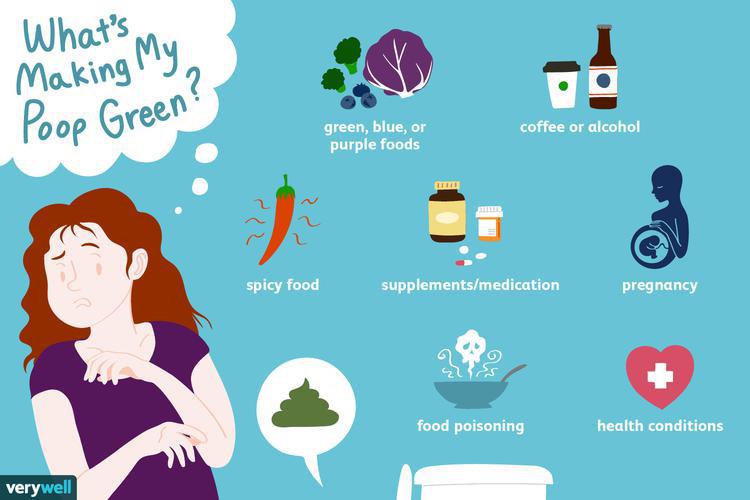The change in color of stool, green stool may mean that you are eating green vegetables (rich in chlorophyll) or green, blue, or purple food coloring, or it may be due to any condition that leads to diarrhea or loose stools.
Although normal stool is brown, occasionally green stool can fall within the range of normal stool colors. If green stool (or any other abnormal stool color) persists or if you have other symptoms, such as fever, diarrhea, nausea, vomiting, or pain, see a doctor.
Here are eight possible causes of green stool (whether it is dark, light, bright green, or floating).

Green Foods
Green stool may simply be the result of consuming meals with green vegetables, such as spinach, kale, broccoli, Swiss chard, collard greens, beets, arugula, and watercress. It does not mean there is a problem. Dark green leafy vegetables are very rich in chlorophyll, the pigment that gives plants their color.
Virtually any chlorophyll-rich plant food can cause green stool if you eat enough of it. This includes vegetables like green beans, celery, sugar snap peas, green peppers, Brussels sprouts, peas, asparagus, bean sprouts, zucchini, cucumbers, and lettuce, as well as fruits like avocados, green apples, honeydew melon, kiwis, green jalapeños, and green grapes. Nuts like pistachios, hemp seeds, and herbs like parsley, basil, and cilantro are also very rich in chlorophyll.
A small serving may not be enough to turn your stool green, but it can be an issue if you are eating larger servings, such as those found in smoothies, juices, pureed soups, large salads, avocado dressings, or combinations of various chlorophyll-rich foods. Matcha, a powdered green tea, can also make stool appear brighter green.
Some foods containing green (or blue and yellow) food coloring can cause your stool to turn green. These dyes are sometimes used in canned green beans, breakfast cereals, candies, pickles, salad dressings, beverages, cakes, and sugar cookies, as well as desserts. You will also see these dyes in foods during St. Patrick's Day and Christmas.
Blue and Purple Foods
In addition to obviously green foods, dark blue or purple foods can sometimes lead to green stool. For example, blueberries, grapes, and red wine can result in dark green stool. Purple food coloring (or red and blue) in mixed drinks, Kool-Aid powder, ice pops, cake, blue Gatorade, packaged fruit snacks, licorice, and grape-flavored Pedialyte can also cause dark or bright green stool. These food dyes are often used during holidays like Easter, Independence Day, and Halloween.
Coffee, Spicy Foods, and Alcohol
When bile passes through the small intestine to the large intestine via the bile duct, it gradually changes color from green to yellow to brown. This is due to the action of bacteria in the large intestine affecting bile salts.
In some cases, consuming large amounts of coffee, jalapeño peppers, chili peppers, and alcohol can have a laxative effect, causing food to pass through the intestines faster than normal (known as decreased transit time) and before the stool changes color from green to brown.
Vitamins, Supplements, and Medications
Taking iron supplements can change the color of your stool to dark green (or black), while other vitamins, supplements, and certain teas can lead to green stool, including:
- Senna (a laxative), cascara sagrada, rhubarb, fiber supplements, and other laxatives.
- Dietary supplements containing chlorophyll, such as green powder, green tea, wheatgrass, spirulina, barley grass, chlorella (which is a type of microalgae), blue-green algae, and chlorophyll.
- Yerba mate tea
- Medications that can cause loose stools or diarrhea as a side effect, such as metformin, Lexapro (escitalopram), Nyquil, Zoloft (sertraline), or antibiotics like ciprofloxacin.
Special Diets
Whether you are following a generally healthy diet or are vegetarian or vegan, consuming a lot of green vegetables and chlorophyll-rich fruits can make your stool green. Juicing or blending fruits will also provide you with a higher intake of chlorophyll and thus increase the likelihood of having green stool.
If you notice green stool during a bowel cleanse, it may be because food is passing through the intestines too quickly for bacteria to turn your stool the characteristic brown color.
A high-fat diet, such as a keto diet, can cause your stool to appear slightly bright green. When absorbing more fat, your body produces more bile to digest these fats, and excess green bile can find its way into the toilet.
Pregnancy
Green stool can occur during pregnancy. Some women experience it in the early weeks of pregnancy, sometimes even before getting a BFP ("big fat positive") on a pregnancy test. Other women may have this condition because they are taking prenatal vitamins (which contain higher doses of iron than regular multivitamins) or iron supplements.
Green stool can also occur in the third trimester. Some women have loose green stools in the later stages of pregnancy due to food moving quickly through the intestines.
Green Stool in Infants, Toddlers, and Older Children
A newborn's first bowel movement is often blackish green. Known as "meconium," you typically do not see it after the baby is three days old.
Dark green (or blackish green) stool in children can be due to iron supplements and iron-rich foods, such as infant formula. If your baby's stool is black or dark, you should see a pediatrician for evaluation.
If a breastfed baby has green stool, it may be something in the mother's diet, such as green vegetables or foods made with green or purple food coloring. In some cases, it could be a sensitivity or allergy to something in the mother's or baby's diet.
Green stool in breastfed infants (especially "EBF" or exclusively breastfed babies) can also be a sign that the baby is getting too much low-calorie, low-fat milk (the milk available at the beginning of a feeding) and not enough higher-fat milk for subsequent feedings. This may mean the baby is not nursing long enough on each breast or effectively draining the breast or getting excess breast milk. A lactation consultant can help identify the issue.
Children often eat foods containing food dyes, including green, purple, blue, and yellow, or red and blue. These are found in grape-flavored Pedialyte and some children's breakfast cereals, drinks, candies, birthday cakes, and cookies. Chewing on green or purple crayons can also change the color of stool.
Conditions That Can Cause Green Stool
Diarrhea decreases transit time in the intestines, so any condition that causes diarrhea can lead to green stool, including:
- Food poisoning
- Diarrhea due to infection or travel (especially Salmonella, E.coli, and Giardia). Intestinal infections caused by bacteria, parasites, and viruses can make your intestines move faster than normal.
- Antibiotic-associated diarrhea (also known as pseudomembranous colitis)
- Lactose intolerance
- Premenstrual syndrome (PMS)
- Celiac disease
- Colitis
- Crohn's disease
- Irritable bowel syndrome (IBS)
- Eating disorders related to laxative abuse
- Post-surgery, such as cesarean section (also known as C-section)
- Graft-versus-host disease. A condition that can develop after a bone marrow transplant.
When to See Your Doctor
It is important to talk to your doctor if you have green stool and/or it is accompanied by fever, abdominal pain or discomfort, blood in the stool (or black stool), loose or watery stools, or other symptoms. A rare but serious cause of green stool in children and adults is chemical poisoning, such as the pesticide paraquat.
Green stool accompanied by visible mucus may signal irritation or inflammation in the intestinal lining. If it occurs frequently, it may be a sign of a condition that needs treatment (especially if it is accompanied by diarrhea, constipation, abdominal pain, or nausea or vomiting).
Like green stool, floating green stool is often normal and related to what you have eaten. In some cases (especially if it is a persistent issue), floating stool may mean that your intestines are not absorbing fat properly.
A Word to the Wise
Green stool can fall within the range of normal colors when having a bowel movement. While continuously changing stool color or the presence of other symptoms may signal something that needs medical treatment, in most cases, occasionally having green stool is nothing to worry about. If your green stool is caused by something you ate, your stool will return to its normal color within a day or two.
